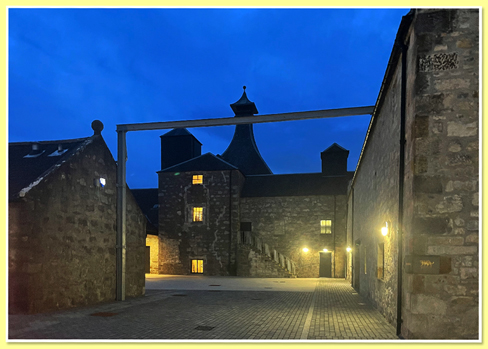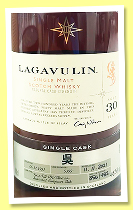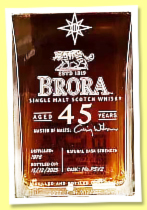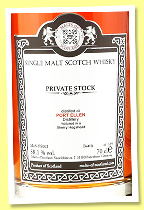| |

Home
Thousands of tastings,
all the music,
all the rambligs
and all the fun
(hopefully!)



Whiskyfun.com
Guaranteed ad-free
copyright 2002-2024
|
 |
|
| Hi, this is one of our (almost) daily tastings. Santé! |
| |
|
| |
| |
December 24, 2024 |
|
  |
Have a wonderful Christmas Eve!
We have always loved whisky adverts around Christmas time—here’s one from White Horse in 1966. That particular White Horse must certainly have contained one, if not two, of the malts we’ll be tasting today. We’ve prepared a surprise tasting for you tomorrow...
|
|
 |

|
WF’s Little Duos: Today Lagavulin vs. Brora (plus bonus) |

|
| Brora by night, June 2024 (WF Archive) |
It’s highly unusual here to compare two whiskies from different distilleries, but after all, both are part of the Diageo stable, and one might not exist without the other. Indeed, it’s well known that the shortage of peated whisky production on Islay at a time when demand for "smoky" blends like Johnnie Walker was on the rise led Diageo’s predecessor, the D.C.L., to seek alternatives on the mainland. Following experiments at several distilleries, they eventually settled on the disused Clynelish distillery, which had been closed for two years.
Sure, Port Ellen had been revived in 1967, but Islay faced a severe drought in 1968, and Caol Ila at the time was much smaller than it is today. Interestingly, after several trials using malted barley from Ord, it was in May 1969 that the DCL board concluded that the new peated distillate from Clynelish II (which would officially become Brora in December of that same year) was now “indistinguishable from the output of Lagavulin” as well as from their other two Islay distilleries. In hindsight, such a claim seems exaggerated after having tasted over 160 different expressions, but the legend of Brora was beginning to take shape…
It’s worth noting that other distilleries also started producing heavily peated whiskies around this time, including Glen Garioch, which became part of Bowmore’s portfolio shortly after, Springbank (with Longrow), and Tobermory (producing Ledaig). Perhaps it was during this period that the general public started associating Scotch whisky as a whole with being “smoky.” Even today, you still meet people who shy away from Scotch whisky because they believe it’s all “smoky.” Crazy, isn’t it? |

|
Lagavulin 30 yo 1991/2021 (45.5%, OB, Casks of Distinction, First-fill PX/Oloroso seasoned European oak, cask #5399, 482 bottles) 
A Cask of Distinction purchased and bottled for Asia, as many of them are. Occasionally, a few bottles find their way back to Europe, though I must admit I’ve never seen anything from this particular cask, even if we’ve already tasted several of these 1991 ‘COD’ ex-first-fill sherry casks with closely related numbers. As they say, this stuff is dynamite, baby. What’s more, casks with a relatively low ABV often provide some additional surprises. Colour: full gold. Nose: good heavens, such compactness and robustness. To start, it’s like a liquid product designed to clear your sinuses, full of camphor, eucalyptus, and similar notes. Then it begins to unleash a barrage of aromas, each more powerful than the last, not necessarily in a very orderly fashion, but with a sense of overwhelming invasion that you can do nothing to stop. Seaweed, pepper, brine, shellfish, green walnuts, miso, peat smoke, resinous smoke, bitter oranges, myrtle, iodine tincture, balms, thuja wood, tobacco, fresh leather, tar, new rubber, saffron, coriander, fresh plastic… you see, it’s quite monstrous. Did we already mention myrtle? I think it’s time to call in the Anti-Maltoporn Brigade. Mouth: incredibly powerful despite the officially moderate strength, and once again, you feel as if you’ve been silenced (and who said “about time,” eh?). Lots of tar, oysters, liquorice, and both black and green olives, along with anchovies in brine, bitter orange, cinchona, ashes, and simply what we call "peat." A massive sense of satiation—this Lagavulin almost nourishes you—but will the finish keep up at this level, given the ABV?... Finish: oh yes, it does, and this is where it feels the most quintessentially ‘Lagavulin.’ Peppery tar, zest, curry, and more shellfish. Quite an impressive length, with almost refreshing peppermint at the very end. Comments: we told you so, didn’t we? And let’s also say it—there’s even a little nod to ‘Jamaica’s HMPDN’.
SGP:567 - 93 points. |

|
Brora 45 yo 1978/2023 (49.4%, OB, Casks of Distinction, cask #P5V2, 255 bottles, 2024) 
A new Cask of Distinction presented in the legendary square decanter rather than the series’ traditional bottle, and bottled exactly one year ago, on 15 December 2023. At Diageo, there often seems to be a ‘certain time’ between bottling and the release of these prestigious series. I’ll add that, in theory, these 1978s are generally less peaty than the early 1970s, of course, but also some 1977s, which are relatively uncommon yet have recently surprised us with their power. Colour: pure gold. Nose: you cannot deny a certain kinship with Lagavulin, though let’s say this is less ‘coastal’ and more about waxes, putty, and turpentine. It’s also less medicinal overall, more refined and elegant, with essential oils, a faint farmy touch often noted in the past (think an impeccably clean stable, with saddle leather), and Japanese seaweed—wakame and the like—served with fresh langoustines, all laid on a bed of clay. In short, on the nose this is a rather delicate and elegant 1978 Brora, with smoke that envelops everything but never tries to dominate. Mouth: very distinctive, markedly further from Lagavulin on the palate, leaning more towards top-quality green teas, soft resins, and citrus zests, followed by a slightly peppery and petrol-like character with a faint prickle. Pine bud-steamed fish, gum arabic, a touch of fresh rubber, then hints of yellow chartreuse and peppery honey. To be honest, it becomes increasingly "Brora" as it evolves. With a drop of water just to test: the salinity comes to the forefront, with an overall profile reminiscent of an old Talisker, which won’t surprise many. Magnificent. Finish: good length, eminently Brora, more lemony, more peppery, and more... medicinal. The oak is more prominent in the aftertaste—it may be that a few more years would have been slightly excessive. Comments: an old Brora that edges into the ‘resinous era’ after 45 years in the cask. Well, that suits it beautifully. The Lagavulin had a modern touch, while this Brora feels more, let’s say, traditional. We think it would be inelegant to assign them different scores.
SGP:465 - 93 points. |
Excuse me? Port Ellen? But of course! We’ve already tasted quite a few fairly young PEs this month, though I’m not sure whether they’ll have been published by the time you read this (no that’s tomorrow – S.). No matter—let’s add another, slightly ‘older’ Port Ellen to this little session. |

|
Port Ellen 1982/2024 (58.1%, Malts of Scotland, Private Stock, sherry hogshead, cask #MoS PS002, 169 bottles) 
2023 and 2024 have been landmark years for Malts of Scotland and their líder máximo Thomas, with numerous quite breath-taking releases that, most importantly, have been markedly different from what most other independents typically offer. While others often release batches in waves—think Teaninich, Fettercairn, Benrinnes, Ben Nevis, Benriach, Loch Lomond, Glen Scotia, Inchgower, Glentauchers, Ledaig, or the secret Laphroaigs, Ardbegs, HPs, or even the mythical Malt Mills (just joking)— ‘MoS’ has taken a different approach, and this remarkable Port Ellen is a perfect example. Unless, of course, a wave of independent Port Ellens is on the horizon, though that seems unlikely, doesn’t it? Colour: amber. Nose: despite the age, this is more brutal, more rustic than Brora, peatier too, more mineral, almost chalky, and of course tarry. There are also pencil shavings, more chocolate, and coffee, undoubtedly from the sherry cask. Sour cherry jam and tobacco are present as well, but ultimately, it’s the coal tar that rules the roost at cask strength. With water: not much change, except it sharpens up dramatically, which we thoroughly enjoy. A striking mineral precision, quite unexpected from a sherry cask, along with hints of verbena and absinthe ‘just for fun.’ Overall, it’s a touch more compact than the noses of the other two. Mouth (neat): immensely powerful, packed with ashes and peppery lemon. What a beast! It even evokes holly eau-de-vie—sadly hard to find these days, as no one seems to drink it anymore. Philistines! With water: tighter, almost youthful, saltier, and still ultra-precise. Pepper and hints of pine bark (or something similar). Finish: extremely long, almost violent at this stage—this is precisely what struck us in the first Port Ellens, like the Rare Malts. The aftertaste brings liquorice, resins, and salted tar. No prisoners. Comments: let’s stay gentlemen—there’s no question of scoring this one higher than the others.
SGP:567 - 93 points. |
… I must admit to having a very, very slight preference for the Brora in the end, due to its extra touch of elegance. Right then, until next time! |
(Danke schoen Dave, Gene, and Wei Jie) |
|
|
| |
|
|
|
|
|
|

